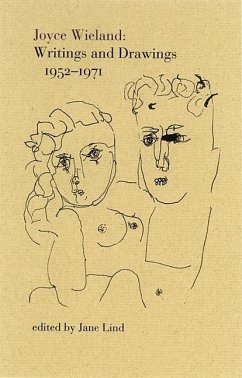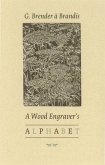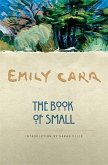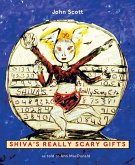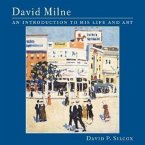Joyce Wieland
Writings and Drawings 1952-1971
Herausgeber: Lind, Jane
Joyce Wieland
Writings and Drawings 1952-1971
Herausgeber: Lind, Jane
- Broschiertes Buch
- Merkliste
- Auf die Merkliste
- Bewerten Bewerten
- Teilen
- Produkt teilen
- Produkterinnerung
- Produkterinnerung
A look at the early aspirations and fears of a young woman who would become the renowned Canadian artist Joyce Wieland. A very fascinating personal story unfolds in a series of diaries, kalideiscopic streams-of-consciousness and sketches, of a self-developing individuality and of the philosophical literacy of one of Canada's great artistic innovators.
Andere Kunden interessierten sich auch für
![A Caledon Sketchbook A Caledon Sketchbook]() Richard B NevittA Caledon Sketchbook17,99 €
Richard B NevittA Caledon Sketchbook17,99 €![A Wood Engraver's Alphabet A Wood Engraver's Alphabet]() A Wood Engraver's Alphabet16,99 €
A Wood Engraver's Alphabet16,99 €![Emily Carr Emily Carr]() Maria TippettEmily Carr22,99 €
Maria TippettEmily Carr22,99 €![The Book of Small The Book of Small]() Emily CarrThe Book of Small18,99 €
Emily CarrThe Book of Small18,99 €![Shiva's Really Scary Gifts Shiva's Really Scary Gifts]() John ScottShiva's Really Scary Gifts20,99 €
John ScottShiva's Really Scary Gifts20,99 €![David Milne David Milne]() David P SilcoxDavid Milne15,99 €
David P SilcoxDavid Milne15,99 €![Hanging Fred and a Few Others Hanging Fred and a Few Others]() Nick FondaHanging Fred and a Few Others29,99 €
Nick FondaHanging Fred and a Few Others29,99 €-
-
-
A look at the early aspirations and fears of a young woman who would become the renowned Canadian artist Joyce Wieland. A very fascinating personal story unfolds in a series of diaries, kalideiscopic streams-of-consciousness and sketches, of a self-developing individuality and of the philosophical literacy of one of Canada's great artistic innovators.
Hinweis: Dieser Artikel kann nur an eine deutsche Lieferadresse ausgeliefert werden.
Hinweis: Dieser Artikel kann nur an eine deutsche Lieferadresse ausgeliefert werden.
Produktdetails
- Produktdetails
- Verlag: Porcupine's Quill
- Seitenzahl: 224
- Erscheinungstermin: 1. April 2010
- Englisch
- Abmessung: 221mm x 139mm x 22mm
- Gewicht: 394g
- ISBN-13: 9780889843219
- ISBN-10: 088984321X
- Artikelnr.: 26611696
- Herstellerkennzeichnung
- Libri GmbH
- Europaallee 1
- 36244 Bad Hersfeld
- gpsr@libri.de
- Verlag: Porcupine's Quill
- Seitenzahl: 224
- Erscheinungstermin: 1. April 2010
- Englisch
- Abmessung: 221mm x 139mm x 22mm
- Gewicht: 394g
- ISBN-13: 9780889843219
- ISBN-10: 088984321X
- Artikelnr.: 26611696
- Herstellerkennzeichnung
- Libri GmbH
- Europaallee 1
- 36244 Bad Hersfeld
- gpsr@libri.de
Joyce Wieland (1930-1998) was an artist who, during her career of nearly forty years, broke down many barriers women faced in a male-dominated art world. As part of her strong survival instinct, she developed a sharp wit and acute ability to find the dramatic aspects of life with their humorous incongruities. She translated what she saw into visual images and words, revealing her own unique way of seeing. Wieland worked in whatever medium and genre she required to articulate what she wanted to say: drawing, painting, collage, multimedia constructions, fabric works, experimental films, cartoons, words. Her cartoons and writing -- playing with language -- are not so well known but must be included in a list of her media. Throughout her life she wrote sporadically; she was most consistent at keeping a journal during blocks of time in her youth. She jotted down her thoughts about art, wrote profiles of people she knew, and tried stream-of-consciousness poems. Wieland came into adulthood during an era of our history that was extremely repressive, especially for women. All of her work is grounded in her experience as a woman and her personal vision as a Canadian. That the subject of some of her earliest work was explicitly sexual is somewhat astounding, given that she began working as an artist in the 1950s when generally only male artists were `privileged' to draw and paint nudes. Regardless of the medium she chose to express herself, from the beginning, her origins fed her process of making art. Wieland grew up in a rough-and-tumble atmosphere. Her father was part of a long line of British pantomime performers who played in the music halls and theatres of London -- including Theatre Royal, Drury Lane -- as early as 1839. George Wieland, Joyce's great grandfather was a famous nimble clown, unequaled in his time. Two of her great aunts, Clara and Zaeo, who gave Joyce a sense of family pride, were well-known dancers who also performed circus acts. In her mother's family, the Coopers, Joyce also found a role model, her grandmother. Mary Jane Cooper Watson was an independent woman who opened a sweet shop after her husband, Charles Watson, deserted the family. Their home was in the small hamlet of Cotton Mill north of Nottingham, England where lace making was the dominant industry. Joyce claimed her grandmother as her personal inheritance for that independent spirit, just as she claimed her paternal great aunts for their daring. Joyce's mother, Rosetta Amelia, was a feisty girl nicknamed Billy when she was young, probably because she developed a reputation as a tomboy. When she was a teenager, she left home and went off to London where she met Sidney Wieland and fell in love with him. The two began living together even though Sidney had another wife and two children. In 1925, Sidney Wieland, Joyce's father, left England for New York. The next year he sent for Joyce's mother, who left behind in England their two children, six-year-old Sidney and five-year-old Joan, in the care of acquaintances. By the next year, Sidney and Billy were living in Toronto. When they received a letter from friends saying the children were being mistreated, they sent the money for their fare, and their friends sent them to Canada by ship. The birth of Joyce in 1930 in Toronto was the family `accident' at the beginning of one of the worst decades in the city's history. They lived in a tiny house on Claremont Street in a working-class Toronto neighbourhood of immigrants near Bathurst and Queen Streets. Though Sidney worked as a waiter at the largest hotel in the British empire, the Royal York, he could barely support his family on his meagre earnings. He was among the many who stole food in desperation during the Depression years; it was easy for him to pilfer meats and pastries from the hotel to supplement buying groceries. Billy did what she could, looking after the house, cooking, and sewing for the family. An accomplice with Sidney, she stitched pockets to the inside of his coat where he could hide whatever he chose to bring home, one pocket that was even big enough to hold a whole chicken. In the midst of the family poverty, Joyce discovered very quickly that she was her father's favourite; he indulged her by allowing her to eat what she wanted and do as she pleased. Sidney Wieland's cunning, coupled with his wit, served him well in a struggle for survival. Despite his best efforts, he did not stave off the feeling of deprivation in the household, and things became even worse for Billy and the three children when Sidney died of heart disease in 1937. He left behind a family with little means of support. Billy made rag rugs to sell; Joan and the younger Sidney had to find jobs. The three Wieland children were orphaned four years later when Billy died of bowel cancer. Joan, a

